6 Orbit / Lids / Adnexa
Anatomy
Dimensions
Orbit
pear-shaped (widest diameter is 1 cm posterior to orbital rim); 40 mm wide, 35 mm high, 45 mm deep, volume = 30 cc (Table 6-1)
| Orbit | Bones | Related structures/miscellaneous |
|---|---|---|
| Roof | Sphenoid (lesser wing) | Lacrimal gland fossa |
| Frontal | Trochlea | |
| Supraorbital notch (medial) | ||
| Lateral wall | Sphenoid (greater wing) | Lateral orbital tubercle of Whitnall |
| Zygomatic | Strongest orbital wall | |
| Lateral orbital rim at equator of globe | ||
| Floor | Maxilla | Contains infraorbital nerve and canal |
| Palatine | Forms roof of maxillary sinus | |
| Zygomatic | ||
| Medial wall | Sphenoid | Lacrimal sac fossa |
| Maxilla | Adjacent to ethmoid and sphenoid sinuses | |
| Ethmoid | Posterior ethmoidal foramen | |
| Lacrimal | Weakest orbital wall |
Optic nerve
orbital length = 25–30 mm; length from globe to optic foramen = 18 mm; width = 1.5 mm in globe, 3.5 mm posterior to lamina cribrosa (due to myelin), 5.0 mm with the addition of the optic nerve sheath (see Figure 4-2)
Proptosis
| Mean (mm) | Upper Limit of Normal (mm) | |
|---|---|---|
| Caucasian male | 16.5 | 21.7 |
| Caucasian female | 15.4 | 20 |
| African American male | 18.5 | 24.7 |
| African American female | 17.8 | 23.0 |
Apertures
(Figures 6-1 to 6-3)

Figure 6-1 Bony anatomy of the orbit in frontal view.
(From Dutton JJ: Atlas of Clinical and Surgical Orbital Anatomy, Philadelphia, WB Saunders, 1994.)

Figure 6-3 Schematic representation of the landmarks, temporal view.
(From Bajandas FJ, Kline BK: Neuro-Ophthalmology Review Manual, Thorofare, NJ, Slack, 1988.)
Inferior orbital fissure
Vascular Supply to Eye
(Figures 6-4 to 6-6)

Figure 6-4 Arterial supply to the orbit, in coronal view.
(From Dutton JJ: Atlas of Clinical and Surgical Orbital Anatomy, Philadelphia, WB Saunders, 1994.)
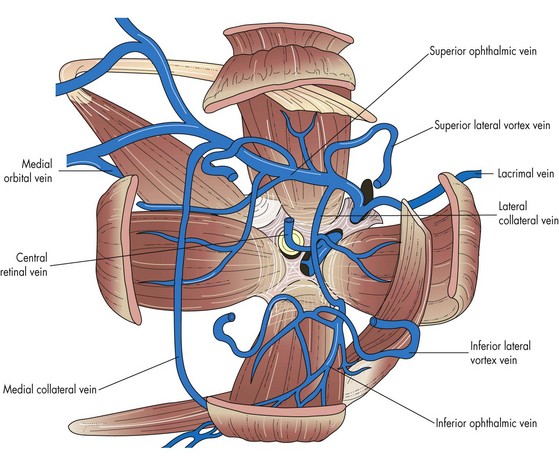
Figure 6-5 Orbital veins. Venous drainage from the orbit, in coronal view.
(From Dutton JJ: Atlas of Clinical and Surgical Orbital Anatomy, Philadelphia, WB Saunders, 1994.)
Ophthalmic artery
Innervation of Eye
Sensory innervation provided by ophthalmic and maxillary division of trigeminal nerve (CN 5) (Figure 6-7)

Figure 6-7 Sensory nerves of the orbit, in lateral view.
(From Dutton JJ: Atlas of Clinical and Surgical Orbital Anatomy, Philadelphia, WB Saunders, 1994.)
Sinuses
Soft Tissues

Figure 6-9 Sagittal section of orbital tissues through the vertical recti.
(Adapted from Parks MM: Extraocular muscles. In Duane TD Clinical Ophthalmology, Philadelphia, Harper and Row, 1982.)
Adipose tissue
Eyelid
Lamellae of upper eyelid: (Figure 6-10)

Figure 6-10 Cross section of upper eyelid. Note position of cilia, tarsal gland orifices, and mucocutaneous junction.
(Reprinted with permission from Grand MG: Basic and Clinical Science Course, Section 2: Fundamentals and Principles of Ophthalmology. American Academy of Ophthalmology, San Francisco, 1993.)
Skin
Orbicularis oculi: (Figure 6-11)
Other muscles of forehead and eyebrow
Orbital septum
Upper eyelid retractors
Lower eyelid retractors
Medial canthal tendon
Eyelid margin
Vascular supply
Nasolacrimal System

Figure 6-17 Excretory lacrimal system.
(From Grand MG: Basic and Clinical Science Course, Section 2, Fundamentals and Principles of Ophthalmology, San Francisco, American Academy of Ophthalmology, 1993.)
Imaging
Ultrasound
Optimal sound wave frequency is 10 MHz
Higher frequencies give better resolution; lower frequencies provide better penetration (Table 6-4)
| Good sound transmission | Poor sound transmission |
|---|---|
| Cavernous hemangioma | Metastatic cancer |
| Lymphangioma | Orbital pseudotumor |
| Mucocele | Glioma |
| Dermoid | Neurofibroma |
| High Reflectivity | Low Reflectivity |
| Neurofibroma | Metastatic cancer |
| Fresh hemorrhage | Orbital pseudotumor |
| Hemangioma | Cyst |
| Thyroid eye disease | Mucocele |
| Varix | |
| Dermoid | |
| Lymphoma |
MRI
Radiofrequency pulse disturbs the alignment by energizing protons or neutrons
Can provide axial, coronal, and sagittal views
Relaxation times
CT Scan
Disadvantages
poor posterior fossa detail; no sagittal sections, ionizing radiation
| Most common orbital lesions with well-circumscribed appearance on CT and MRI | Most common orbital lesions with Ill-defined appearance on CT and MRI |
|---|---|
| Children: | Children: |
| Dermoid cyst | Capillary hemangioma |
| Lymphangioma | Orbital pseudotumor |
| Rhabdomyosarcoma | Plexiform neurofibroma |
| ON glioma | Leukemic infiltrate |
| Eosinophilic granuloma | |
| Adults: | Adults: |
| Cavernous hemangioma | Orbital pseudotumor |
| Neurofibroma | Metastasis |
| Neurilemmoma | Leukemic infiltrate |
| Fibrous histiocytoma | Primary malignant tumor |
| (Lymphoproliferative disorders) | Lymphoproliferative disorders |
Orbital Disorders
Trauma
Orbital Fractures
Fractures of orbital bones, often associated with ocular or intracranial injuries
Orbital floor (blow-out)
Zygomatic (tripod)
Intraorbital Foreign Bodies
Commonly associated with intraocular and / or optic nerve injury
Inert material can be well tolerated and may be observed
Copper and organic material are poorly tolerated and must be removed
Often asymptomatic, but may have pain or decreased vision
CT scan (MRI is contraindicated for metallic foreign bodies)
Degeneration
Infections
Fungal
Mucormycosis
Inflammation
Idiopathic Orbital Inflammation (Orbital Pseudotumor)
Idiopathic inflammatory disease of orbital tissues
Children
bilateral in 33%; commonly have headache, fever, vomiting, and lethargy; may have associated papillitis or iritis; work up usually not needed (see Ch. 5, Pediatrics / Strabismus)
Diagnosis
Orbital myositis
localized to extraocular muscles MR and LR most commonly involved (33% each), IR 10%
Thyroid-Related Ophthalmopathy
Autoimmune disease with spectrum of ocular manifestations
Most common cause of unilateral or bilateral proptosis in adults
Most common cause of acquired diplopia in adults
Women affected 8–10× more often than men
Associated with myasthenia gravis (in 5% of patients with Graves’ disease)

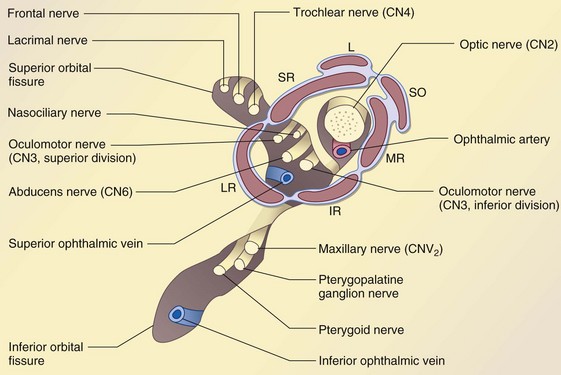
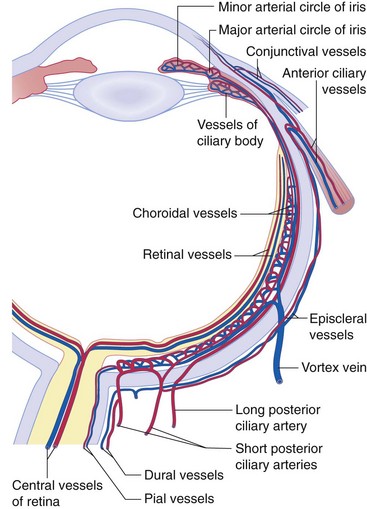
 of retina
of retina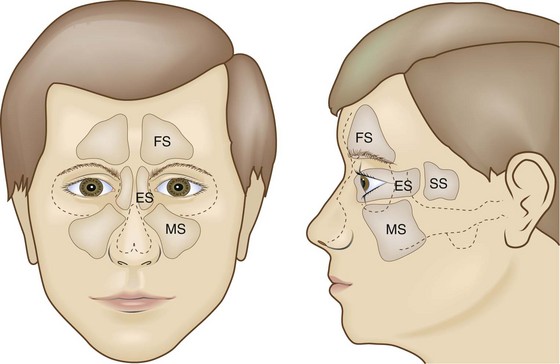
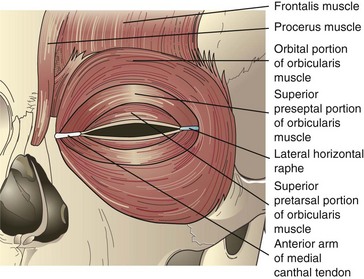
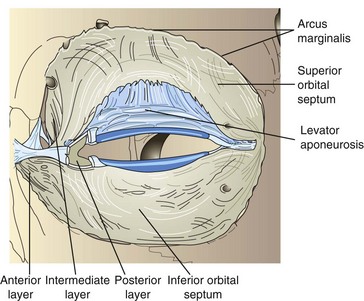
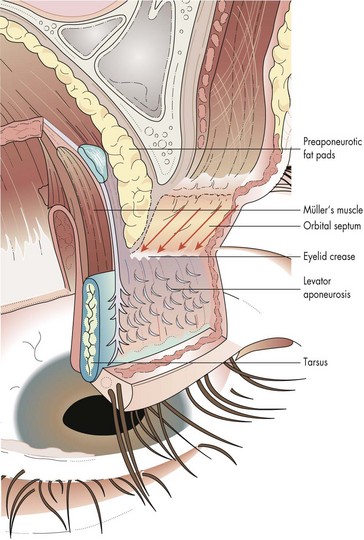
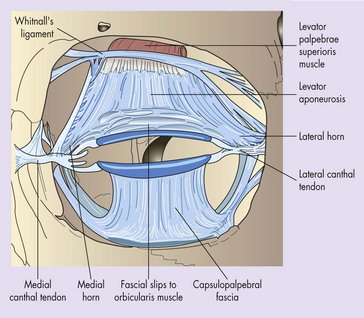
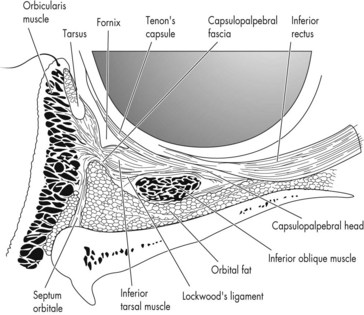
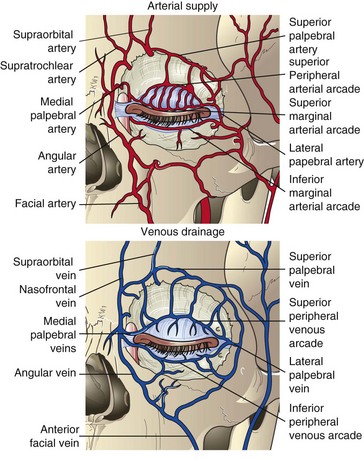
 of upper lid, medial
of upper lid, medial  of lower lid
of lower lid of upper lid, lateral
of upper lid, lateral  of lower lid
of lower lid



